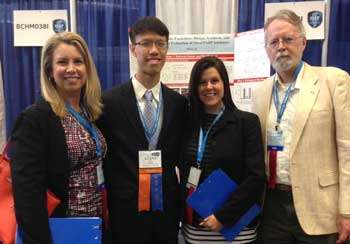A project identifying novel compounds that could be used for pain relief was awarded a first place Addiction Science Award at the 2015 Intel International Science and Engineering Fair (ISEF)—the world’s largest science competition for high school students. The awards are coordinated by the National Institute on Drug Abuse (NIDA), part of the National Institutes of Health, and Friends of NIDA, a coalition that supports NIDA’s mission. The Intel ISEF Addiction Science Awards were presented at a ceremony Thursday night at the David L. Lawrence Convention Center in Pittsburgh.
The first place distinction was awarded to Glenn Yu, a high school senior at the Hunter College High School in New York City for his project, Naturalistic Painkillers: Design, Synthesis and Biological Evaluation of Novel Fatty Acid Binding Protein Inhibitors. The 17-year-old student used computational modeling, chemical synthesis of analogs and biological testing to identify and theoretically build a more effective and safer pain reliever. The novel compounds he developed are designed to affect the endocannabinoid system, which has proven effects on pain inflammation, stress and drug withdrawal.
 First place winner of 2015 Addiction Science Award (L-R): Judge Dr. Colleen McClung, Winner Glenn Yu; and Judges Dr. Cynthia Conklin and Dr. Kenneth Perkins
First place winner of 2015 Addiction Science Award (L-R): Judge Dr. Colleen McClung, Winner Glenn Yu; and Judges Dr. Cynthia Conklin and Dr. Kenneth Perkins“This innovative project was a sophisticated approach to solving an ongoing scientific problem: how to develop a pain reliever that does not have the potential side effects of commonly prescribed medications, including addiction,” said NIDA Director Nora D. Volkow, M.D. “Mr. Yu identified compounds that, if used together, could represent a novel approach to pain management.”
The second place distinction went to Ralph Lawton, a 16-year-old student at the Pennsylvania Leadership Charter School-University Scholars Program, in West Chester. The high school junior’s project, Don’t Be Led Ashtray: Toxicological Effects of Electronic Cigarettes on Inflammation and Lung Cell Viability with Comparison by Brand, Flavor and Generation, looked at the toxicological effects of e-cigarette vapor on lung cell viability and inflammation. Using a strong comparison to tobacco cigarettes, his project suggests that tobacco vapor can be just as damaging to lung cells as traditional cigarette smoke.
Winning third place was Kashfia Nehrin Rahman, a freshman at Brookings High School in Brookings, South Dakota. Her project, titled Nomophobia: Effects of Smartphone Dependence and Separation on Stress, Anxiety, Memory and Cognition in Developing Adolescent Brain, found direct correlation between stress and the temporary loss of a cell phone, which she called “nomophobia” for “No More Mobile Phone.” The judges were impressed with her understanding of the developing teenage brain, a major factor in the negative health effects of drug use.
“Our second and third place winners gave a scientific structure and analysis to challenging trends in our current cultural behaviors, which will contribute to our baseline knowledge of their health effects,” added Dr. Volkow.
The judges made the unusual move of offering honorable mention distinctions to two additional projects, A Novel Animal Model to Replicate Alcohol-Seeking Behavior in Humans by 16-year-old student Ajitha Mallidi from Westview High School in Portland, Oregon, and Improving the Efficiency of Genome Variants Detection by the Parallelization of its Computer Process, by 15-year-old student Lucas Lopes Cendes from the Escola Americana de Campinas, in Sao Paulo, Brazil.
Judges for this year’s Addiction Science Award included three NIDA grantees from the University of Pittsburgh: Cynthia A. Conklin, Ph.D., Colleen A. McClung, Ph.D., and Kenneth A. Perkins, Ph.D.
The Friends of NIDA provides funding for the awards as part of its ongoing support of research into the causes, consequences, prevention, and treatment of drug abuse and addiction.
“Once again we are delighted to be a part of this inspiring science fair, and hope that we can encourage many of these bright young scientists to pursue the exciting field of addiction science,” said William Dewey, Ph.D., president and chair of the Executive Committee, Friends of NIDA, as well as the Louis S. and Ruth S. Harris Professor and chair, Department of Pharmacology and Toxicology, Virginia Commonwealth University, Richmond.
This year, about 1,700 students from 70 countries, regions and territories participated in the Intel ISEF competition, coordinated by the Society for Science and the Public. The nonprofit organization partners with Intel—along with dozens of other corporate, academic, government and science-focused sponsors—to provide support and awards each year. Addiction Science Winners receive cash awards provided by Friends of NIDA, with a $2,500 scholarship for the first-place honoree, $1,500 for second place and $1,000 for the third place distinction. NIDA has developed a special section on its website, which includes other resources on addiction science, to highlight the winning projects and to help science fair entrants understand the criteria for the awards: The NIDA Science Fair Award for Addiction Science.